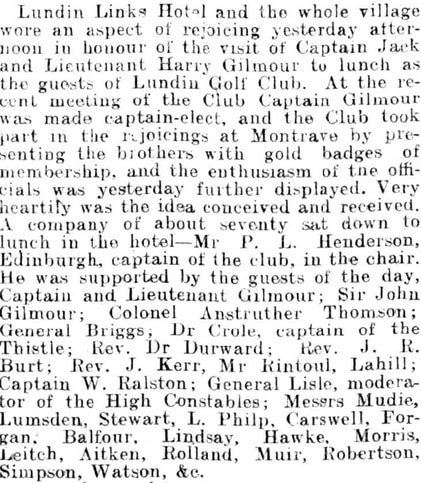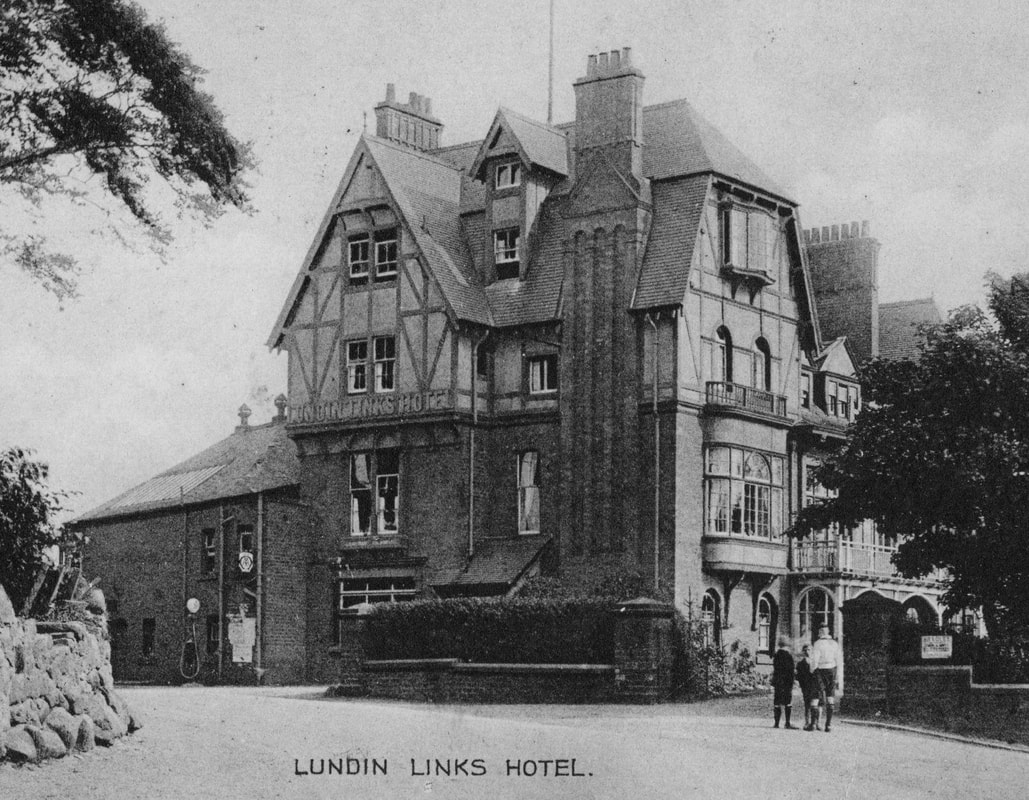The previous post detailed the construction and 1900 opening of the Lundin Links Hotel. The arrival of such a palatial building in the district caused quite a stir. There was a ready-made audience for the hotel in the shape of golf-playing city dwellers of Edinburgh and Glasgow, many of whom were already familiar with the charms of Lundin Links. The year after its launch, the hotel was once again "decked with flags". This time the occasion was the return from the Boer War of Captain Jack Gilmour, of Fife and Forfar Imperial Yeomanry, son of owner of the Lundin estate, Sir John Gilmour. According to the 6 August Scotsman newspaper, "long streamers of the Gilmour colours - green and white - floated between the hotel and other buildings on the opposite side of the street".
The Dundee Courier from 6 August (extract below) tells of how a company of around seventy people enjoyed lunch in the hotel, presided over by hotel architect and then Captain of Lundin Golf Club, Peter Lyle Henderson. Captain Gilmour had recently become Captain-elect of Lundin Golf Club. His brother, Lieutenant Harry Gilmour, was also present at the lunch. He had also taken part in the Boer War and had returned home in March 1901, having been wounded in the head in October 1900.
The hotel with its function rooms and public spaces hosted many special events and dinners. Early examples included retirement celebrations, Largo Curling Club dinners and Largo Silver Band events. As the 1900s went on, Lundin Links continued its growth and development. Not only were new villas being built but new facilities were appearing as well, many of which would benefit hotel guests. In 1903 new shops were erected opposite the hotel on Emsdorf Street in the site of a row of old cottages. The pharmacy and newsagent in particular would have enjoyed the custom of the hotel guests, purchasing postcards, summer requisites, fancy goods and photographic supplies. Below is an example of a postcard purchased in Young's newsagent on Emsdorf Street by a hotel guest. Sent in the 1910s, and featuring the hotel on the other side, the message states "It is a very nice building and I am inside at a game of billiards".
In June 1904 Lundin Links hotel keeper James Schomberg McTavish sailed to Jamaica to take up a management position at the Constant Spring Hotel in Kingston. His brother-in-law Samuel Edwin Duncan (son of Samuel Duncan the Edinburgh tailor) took over management of the Lundin Links Hotel. The advert at the top of this post dates to Sam Duncan junior's early days in charge. It confirms the importance of golfers to the hotel's success. Now dubbed "The Golfers' Resort", the hotel advert was keen to emphasise its proximity to the first tee of the golf links and its special terms for golfers.
In January 1905 it was announced that the Lundin Links Hotel was to be "thoroughly cleaned and renovated under the direction of Mr Sam Duncan. Mr Adam, Lundin Links has been contracted for the painting". Soon afterwards some external enhancements were carried out, including the 'HOTEL' lettering on the front façade and the more subtle 'Lundin Links Hotel' signage beneath the half-timbering on the west-facing side. These three features can all be seen in right hand image in the photo comparison below. The veranda around the front entrance was added in summer 1907 (see Leven Advertiser snippet below from 4 July 1907).
In 1905 the bowling green opened and the tennis courts were completed in Lundin Links, offering additional attractions for hotel guests. And in 1910 the Montrave Hall was opened, following calls from locals and summer visitors for a larger hall capable of hosting a wide range of events and entertainment. The existence of the hotel and the influence of its regular visitors likely contributed to the creation of these facilities. Lundin Links was firmly established as a holiday destination.
As early as 1911, the hotel also acted as a venue for wedding receptions. Although most marriages were celebrated at home in this era, the existence of a smart hotel in the village offered an alternative to those who could afford it. One early example was the wedding reception for the youngest daughter of Andrew Peebles of Highclere. Dora Gwendolene Peebles married George Clark at Largo Parish Church and, after the ceremony, the guests proceeded to the hotel where Mrs Peebles hosted a reception. This modern couple also had 'going-away costumes' and left the hotel directly to go on their honeymoon.
Later in Sam Duncan's years as proprietor of the hotel, it appears that he spent increasing amounts of time in Edinburgh, while live-in managers conducted the day-to-day running of the hotel (including during the years of the First World War). Mangers included Miss Law, Tom Harris and Mrs Jean Sharp. When Harris was managing the hotel in 1920 a fire broke out in the kitchen and spread to the roof. According reports in the Leven Advertiser (14 October) "Mr Tom Harris and his staff...performed wonders in holding the outbreak until the arrival of Firemaster Burnett and his men". These men from Buckhaven Fire Brigade started to cut away the roof in order to check the further progress of the flames, saving the building. Below is the previous evening's Dundee Evening Telegraph report on the incident.
Sam Duncan senior, who had been instrumental in establishing the hotel, died in 1922. By early 1924 the hotel's ownership had passed to Thomas Hogg. Hogg had been a restauranteur in Edinburgh but immediately prior to coming to Lundin Links had been club master at Turnhouse Golf Club. It was around this time, that the hotel introduced improved amenities for car users, including parking spaces and petrol pumps. The pumps can been seen on the left in the 1920s postcard image below. More to follow on how the hotel continued to move with the times....







 RSS Feed
RSS Feed
